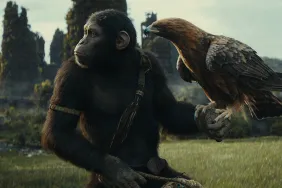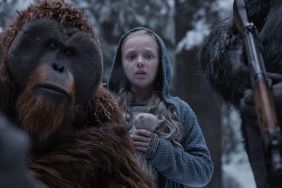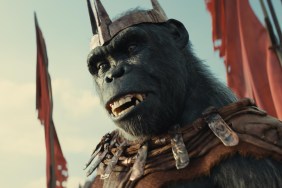
Take a look at nine films and two television series in our Planet of the Apes franchise recap!
The Planet of the Apes franchise is one of those properties that will likely endure until the end of time. After all, it lived on after destruction of the entire planet at the end of just its second film. Since author Pierre Boulle’s original novel in 1963, the series has seen nearly a dozen films, two TV series, and a mountain of comic books, video games, and toys. The story is very simple: apes surpass humans in intelligence and create a world where humans are their servants. With the impending release of War for the Planet of the Apes (hitting theaters July 14th), check out our overview for the full filmic Planet of the Apes franchise!

La Planète des Singes by Pierre Boulle (1963)
The original novel follows a French journalist on a trip to a planet where it turns out that apathy and complacency allowed humans to be overthrown by more industrious apes. As such, the apes now hunt humans for sport and use them for menial tasks. Boulle — who also wrote the source material for David Lean‘s The Bridge on the River Kwai — didn’t like labeling his work as science fiction; instead, he preferred to think of it as “social satire” and “social fantasy.”

Planet of the Apes (Franklin J. Schaffner, 1968)
Rod Serling, creator of The Twilight Zone, wrote the original script for the film, based on Boulle’s novel. It was Serling who changed the ending to show that the planet of the apes that astronaut George Taylor (Charlton Heston) discovered is actually Earth, but in the distant future. (In the novel, the human explorers actually do arrive at a different planet.) That scene, with Heston on the beach, discovering the destroyed Statue of Liberty, is one of the most iconic in film history. Michael Wilson was brought in to rewrite the script, but kept Serling’s twist ending, as well as his Cold War commentary. In order to cut down on production costs, the apes were also made more primitive than in the novel, allowing production to cut down on special effects costs.

Beneath the Planet of the Apes (Ted Post, 1970)
Although not originally planned as such, the Planet of the Apes franchise grew from the enormous success of the first film. Charlton Heston did not want to star in a second Apes film, but he agreed to appear in Beneath, so long as his character died. Instead, James Franciscus starred as Brent, an astronaut sent to find the missing Taylor. He finds him, a prisoner of a sect of mutated, telepathically-enhanced humans who live underground. The apes discover the secret sect, but Taylor ignites an ancient nuclear bomb, killing apes and humans alike.

Escape From the Planet of the Apes (Don Taylor, 1971)
Despite the world being destroyed in a nuclear holocaust, Beneath the Planet of the Apes was a commercial success, and prompted 20th Century Fox to insist on another sequel. They halved the budget, and in order to save on costs, Escape is set in the current-day United States. This also offered the production a chance to “restart” the Planet of the Apes franchise, since the last film destroyed the entire earth. The nuclear explosion created a time warp that allowed Cornelius and Zira to travel back in time, where they hide their ability to speak – but only for a short while. They become celebrities, which increases the scrutiny paid to the two chimpanzees. Zira is pregnant, and the pair eventually escape government confinement and take shelter in a circus. This lasts long enough for Zira to give birth before the pair are on the run again. Hasslein, the President’s science advisor and the primary instigator against Cornelius and Zira, follows the pair to the harbor. Fearing that Zira’s baby will be the catalyst that sets into motion the events that lead to apes taking control of the world, he kills both Zira and the baby. Cornelius kills Hasslein, and a sniper kills Cornelius. But Zira switched her baby with an average gorilla baby, so her hyper-intelligent baby is still alive.

Conquest of the Planet of the Apes (J. Lee Thompson, 1972)
Conquest followed up on the racial themes that were introduced in Escape, but only very lightly touched upon. This film is set in 1991, 18 years after Escape was set. Eight years ago, a plague wiped out cats and dogs, leaving humans without pets. Humans turned apes into pets, and once they saw how intelligent they were, started training them for basic tasks. As the years went on, apes became slaves, beaten and abused by their human slavers. Zira and Cornelius’ baby, who has taken the name Caesar, is now grown up and living as an equal with Armando, the circus master who took him in when his parents were killed. Circumstances cause Caesar to be separated from Armando and put in a cage with a bunch of other “average” orangutans before being sold into slavery. When Caesar learns that Armando died while in the government’s custody, he plots a rebellion with the other apes, training them for war.

Battle for the Planet of the Apes (J. Lee Thompson, 1973)
The fifth and final entry into the original Planet of the Apes franchise was also the lowest-budgeted film, at just over $1 million. While racial issues were explored again through Battle, it had a less finalistic, more hopeful finale. A global nuclear war has decimated the Earth, and Caesar, now the ape leader, tries to develop peace between apes and humans. Aldo, a gorilla general, disapproves, and plots Caesar’s downfall so that he can gain control of the apes and lead them to the future foretold in the original film.

Planet of the Apes (TV series, 1974)
Original producer Arthur P. Jacobs conceived an hour-long television drama based on the Planet of the Apes franchise in 1971, when he thought the fourth film would be the last. The idea was put aside when the studio ordered a fifth film, and Jacobs died a month after Battle premiered. A FOX executive picked up the reigns and brought the series to CBS in 1974. Following much of the plot of the original film, astronauts crash land on a future Earth where apes rule over humans. The ratings were very low, factors that production attributed to repetitive storytelling and a lack of on-screen apes. CBS canceled the series by the end of the year, having aired only 14 episodes.

Return to the Planet of the Apes (TV series, 1975)
After the live-action TV series failed on CBS, NBC decided to try it out as a half-hour animated series. Based solely on the first two films, Return features more astronauts who crash land on a future Earth. There, they discover three distinct “tribes.” Mute subservient humans; intelligent mutant humans who live underground; and “civilized” apes who rule the planet. Much like its live-action counterpart, Return did not last long. 13 episodes aired before it was canceled.

Planet of the Apes (Tim Burton, 2001)
After twenty years of attempts to relaunch the Apes franchise, Fox finally got a version off the ground, directed by Tim Burton. Mark Wahlberg plays the astronaut who lands on future Earth and discovers apes have enslaved humanity. He leads an uprising among humans to overthrow their captors, falls in love with a female ape, and discovers that his simian shuttle assistants didn’t go through the wormhole, so the ape oppressors are their descendants. Poor reviews, a difficult production schedule, and a weak box office made Fox disinterested in producing a sequel.

Rise of the Planet of the Apes (Rupert Wyatt, 2011)
Rise is a reboot of the original Planet of the Apes franchise. Offering a new take on the chimpanzee character of Caesar from Conquest of the Planet of the Apes, Caesar is born to a mother who was given experimental Alzheimer’s medication, greatly increasing her intelligence. That increased intelligence is passed to Caesar when he is born, and he is raised by one of the scientists, Will (James Franco). A series of events leads to Caesar being put into a primate shelter, where he is bullied by the other primates and tortured by his caretaker. While Caesar moves up in the primate hierarchy, a new version of the Alzheimer’s drug is created, one that is stronger and far more experimental than the last. When scientists working on the new drug start to die, Caesar escapes his imprisonment, steals the new drug, and releases it upon his new primate brethren. Caesar leads his battalion of intelligent apes into San Francisco, where they free more primates. They must fight their way through police blockades, killing humans along the way, but they end up in the redwood forest Will exposed Caesar to when he was young, and they make it their new home.

Dawn of the Planet of the Apes (Matt Reeves, 2014)
The “Simian Flu” that was released in Rise has reached pandemic proportions and significantly reduced human population. The apes, on the other hand, thrive under the Simian Flu, with the entire ape population gaining significant increases to their intelligence. The apes, with Caesar at the head, now rule the small number of humans immune to the virus, forcing them to live in a tower in San Francisco. A truce is declared between Caesar and Malcolm, a human, who enters the ape domain to repair a hydroelectric dam. Malcolm smuggles in a gun into the ape domain, which launches a series of events that reveal neither the apes nor the humans trust each other. Koba, an ape, secretly sets fire to the forest and shoots Caesar, blaming it all on the humans and leading his ape followers in an attack against the humans. Caesar survives and tries to quell the violence between the two species, but with the power to the city restored, the humans have reached out to survivors at a military complex. The military is on their way. Caesar kills Koba, makes peace with Malcolm, and regains control of the apes. He is ready for war.

War for the Planet of the Apes (Matt Reeves, 2017)
Set two years after Dawn, a war between humans and apes has been raging, but the ape population has been decreasing. The two species struggle to see who will be the dominant species.









